|
|
PDMAC1759R : Supreme Prosperity & Fulfillment B.E.2525 Set of Triple Medals Phra Kaew Morakot (Thailand Emerald Buddha) 200 years old of Rat (Wat Phrachetuphon (Wat Pho), Bangkok )  with Katha: with Katha: Buddha_PhraKaeoMorakot | | | | 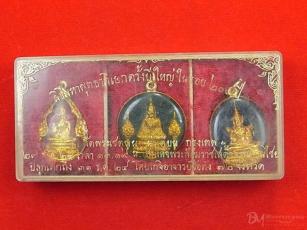 | 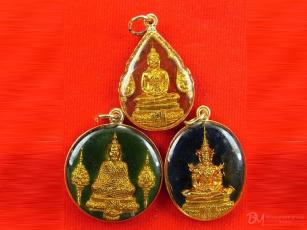 | 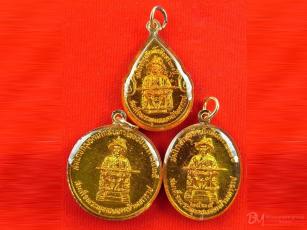 | 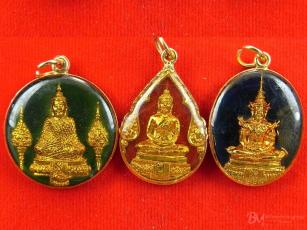 |  | 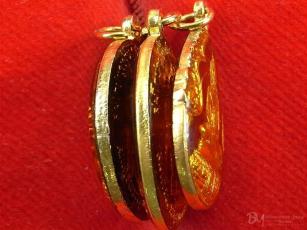 | 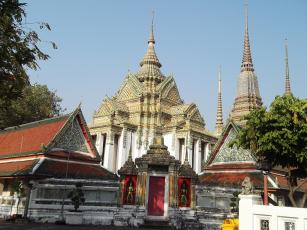 | |
| Great Buddha Amulet from Grandest Blessing Ever in 200 Years!
100% Authentic from the Temple
Name: BE2525 Set of Triple Medals Phra Kaew Morakot (Thailand Emerald Buddha)
Name: 200 years old of Rattanakosin Era
Year: BE2525 (CE1982)
From: Wat Phrachetuphon (Wat Pho), Bangkok
Origin: Thailand
Material:metal plated gold with enamel.
Size: drop shape 2.3 x 3.5 cm/ circle 3 x 3.5 cm/ oval 2.5 x 3.5 cm
Ceremony: Grandest Blessing Ever in 200 Years at Wat Phrachetuphon performed by famous guru monks of 72 Provinces of Thailand from 29 – 31 December CE1982. Supreme Partriarch came and lit ritual candle in the ceremony.
Phra Kaeo Morakot or The Emerald Buddha is the most important Buddha statue in Thailand because it was established as the Buddha statue of Thailand when Rattanakosin Era was established by King Rama the First in 1782. It is kept in Wat Phrasrirattanasatsadaram (Wat Phra Kaew), Grand Palace in Bangkok. It is famous among foreign tourists as an outstanding attraction in Bangkok which they wish to see once in life.
Power:People believe to worship Phra Kaeo Morakot will bring prosperity, authority and propitiousness to life. Phra Kaeo Morakot is also believed to fulfill all wishes.
Feature: This medal set present 3 seasons of Emerald Buddha, one with accessories is hot season, one with robe (open shoulder) is rainy season, and one with cover-all cloth is cold season.
In fact, every year, King of Thailand will go to change dress of Emerald Buddha to particular season dress in Wat Phra Kaew (Emerald Buddha Temple).
Backside of each Emerald Buddha medal has image of King Rama 1 who established Rattanakosin era.
History of Wat Phrachetuphon (Wat Pho) :
Wat Pho is one of Bangkok's oldest temples. It existed before Bangkok was established as the capital by King Rama I. It was originally named Wat Photaram or Podharam, from which the name Wat Pho is derived. The name refers to the monastery of the Bodhi tree in Bodh Gaya, India where Buddha is believed to have attained enlightenment. The date of the construction of the old temple and its founder are unknown, but it is thought to have been built or expanded during the reign of King Phetracha (1688–1703). The southern section of Wat Pho used to be occupied by part of a French Star fort that was demolished by King Phetracha after the 1688 Siege of Bangkok.
After the fall of Ayutthaya in 1767 to the Burmese, King Taksin moved the capital to Thonburi where he located his palace beside Wat Arun on the opposite side of the Chao Phraya River from Wat Pho. The proximity of Wat Pho to this royal palace elevated it to the status of a wat luang ('royal monastery').
In 1782, King Rama I moved the capital from Thonburi across the river to Bangkok and built the Grand Palace adjacent to Wat Pho. In 1788, he ordered the construction and renovation at the old temple site of Wat Pho, which had by then become dilapidated. The site, which was marshy and uneven, was drained and filled in before construction began. During its construction, Rama I also initiated a project to remove Buddha images from abandoned temples in Ayutthaya, Sukhothai, as well other sites in Thailand, and many of these retrieved Buddha images were kept at Wat Pho. These include the remnants of an enormous Buddha image from Ayuthaya's Wat Phra Si Sanphet destroyed by the Burmese in 1767, and these were incorporated into a chedi in the complex. The rebuilding took over seven years to complete. In 1801, twelve years after work began, the new temple complex was renamed Phra Chetuphon Vimolmangklavas in reference to the vihara of Jetavana, and it became the main temple for Rama I.
The complex underwent significant changes over the next 260 years, particularly during the reign of Rama III (1824-1851 CE). In 1832, King Rama III began renovating and enlarging the temple complex, a process that took 16 years and seven months to complete. The ground of the temple complex was expanded to 56 rai (22 acres), and most of the structures now present in Wat Pho were either built or rebuilt during this period, including the Chapel of the Reclining Buddha. He also turned the temple complex into a public center of learning by decorating the walls of the buildings with diagrams and inscriptions on various subjects. On 21 February 2008, these marble illustrations and inscriptions was registered in the Memory of the World Programme launched by UNESCO to promote, preserve and propagate the wisdom of the world heritage. Wat Pho is regarded as Thailand’s first university and a center for traditional Thai massage. It served as a medical teaching center in the mid-19th century before the advent of modern medicine, and the temple remains a center for traditional medicine today where a private school for Thai medicine founded in 1957 still operates.
The name of the complex was changed again to Wat Phra Chetuphon Vimolmangklararm during the reign of King Rama IV.[1] Apart from the construction of a fourth great chedi and minor modifications by Rama IV, there had been no significant changes to Wat Pho since. Repair work, however, is a continuing process, often funded by devotees of the temple. The temple was restored again in 1982 before the Bangkok Bicentennial Celebration.
“This content is copyright and duplication is not permitted. When having an order, can buy a Holy Gift at special price. Click on https://shorturl.at/dosz8”
|
Amulets by Wat Phrachetuphon (Wat Pho), Bangkok
Total 0 Record : 1 Page :
1
Total 0 Record : 1 Page :
1
|
|

